| Home | Revision | A-Level | Economics | Labour Markets | The effects of trade unions |
The effects of trade unions
Trade unions prevent the “normal” market supply and demand of the competitive situation from working perfectly.
There are two kinds of unions:
1. “Inclusive”. These are the normal general trade union we see in the West, such as the Transport and General Workers Union. This is the focus of attention usually.
2. “Exclusive”. These are craft unions, such as the Musicians’ Union.
The Inclusive TU
The trade union negotiates with the employers and an agreed wage is set for the industry, or a factory if negotiating at that level. In effect this says that any firm may hire as many workers as it likes, but it must pay that agreed wage. If it does not pay, there will be trouble with the union, and possibly a strike. Unions try to get a “closed shop”, where every worker hired must be a union member and the union then does the collective bargaining for all workers. The union tries to include all the relevant workers in its ranks.
The Competitive Wage Situation (With No Unions)
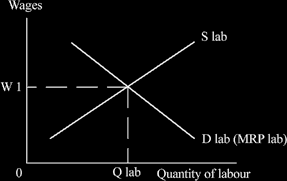
The Situation with an Inclusive Trade Union
In effect, the negotiated agreement alters the supply of labour from the diagram above to the one below: note the new thicker supply curve of labour. The horizontal part
indicates the firm can hire all it likes but only at the agreed wage. As we push out to the
right, once we reach the normal supply curve of labour, the original supply curve becomes operative again. The union cannot force people to work for that wage and has to accept the number of workers that are available and are willing to work. Fewer
workers will be employed although the demand curve for workers has not changed; at the higher minimum wage, we extend back up the existing demand curve.
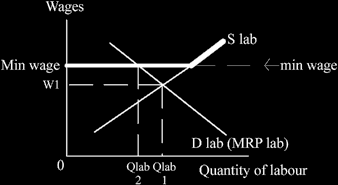
By comparing the situations with and without a union, we can examine the changes in the market:
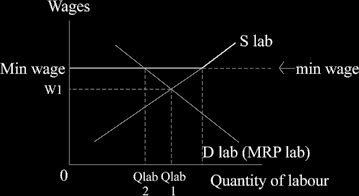
• Without a union: the wage is W1 and the employed workers are at Qlab 1.
• With a union: the wage rises to the minimum agreed wage, but employment falls to Qlab 2.
• And unemployment appears in the industry, as more workers offer themselves for work there (Qlab 3 reading from the supply curve) than are demanded (Qlab 2
reading from the demand curve). So the unemployed are represented by 0Qlab3
minus 0Qlab2 which is the distance Qlab2 Qlab3.
Note: in different textbook diagrams, “the quantity of labour” may be presented as “Q”, “Qlab” or “Qn”; do not let it bother you! Qlab is often preferred as it shows you know you are dealing with labour markets and not, say, with the quantity of tomatoes.
The exclusive trade union
The exclusive union tries to prevent (exclude) workers from working unless they join the union, and to do this they must pass a test. Such unions are common in professions like electricians, musicians, and medical doctors. If such a union can organise in the same was as the inclusive ones above, they might do so. If they cannot organise in this way then:
1. The union may place its effort on trying to restrict the supply of labour in order to increase wages.
2. The union may also try to increase the demand for the workers (its members).
The diagram for a decrease in supply is exactly the same as the one you are used to in microeconomics for the price of any good or service but with altered labels. And it works in exactly the way you are used to.
If the union is suddenly able to prevent non-union people from working, the effect is to move the supply curve upward and to the left.
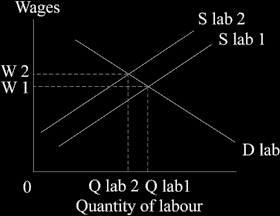
The other effort of the union may be to try to increase the demand for its workers. When I was a member of it, the Musicians Union steadily tried to get the BBC to us more live musicians and fewer recorded music items on what were then called “gramophone records” as CDs had not yet been invented. (Ah, the days in my youth going round doing one night gigs in the good old “MU”; happy but long gone!)
This is the diagram for the union trying to increase demand:
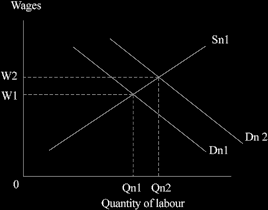
In this diagram I switched to using “Dn1” and “Sn1” etc., so that you get used to the different labels you might encounter in different books and not get put off when you do.
Can unions raise wages?
It used to be believed that they could increase the average level of wages in an industry and maybe achieve a wage some 10-20 per cent above the wages in a non-unionised industry.
But unions are much weaker now than before the 1970s, so some believe that they can have much less effect these days. There is a lot more competition, labour markets work more freely, and unions have simply become less important.
Unions and productivity
Many economists used to believe unions reduced productivity. They did this :
• By demanding, and getting, overstaffing in a firm.
• By protecting bad and disruptive workers and not allowing them to be dismissed despite their negative effects on production.
• By not allowing capital in to replace labour.
Some observers now feel unions can actually improve productivity:
• By providing a safety valve for worker irritation.
• By allowing proper grievances to be heard without a worker being dismissed for complaining or being a trouble maker.
• A happy worker is a productive worker.
Some feel this is sophistry and although they admit that logically it could happen, they feel that the anti-productivity arguments are stronger. It is true that we saw labour productivity increase when unions were weakened after Prime Minister Thatcher successfully attacked the unions. She seemed to believe that the unions had gained such strength that they could resist the government, they were a danger to democracy, and they insisted on protecting individual bad workers to the extent that they were damaging productivity. This increase in labour productivity after the unions were weakened might be accounted for in part at least by the general increase in competition.
(You would be wise in the exam room to present views that can have a political content or impact very carefully and not adopt an extreme position. Some markers have strong political views, either left wing or right wing, and these might colour their impression of you as a student.)